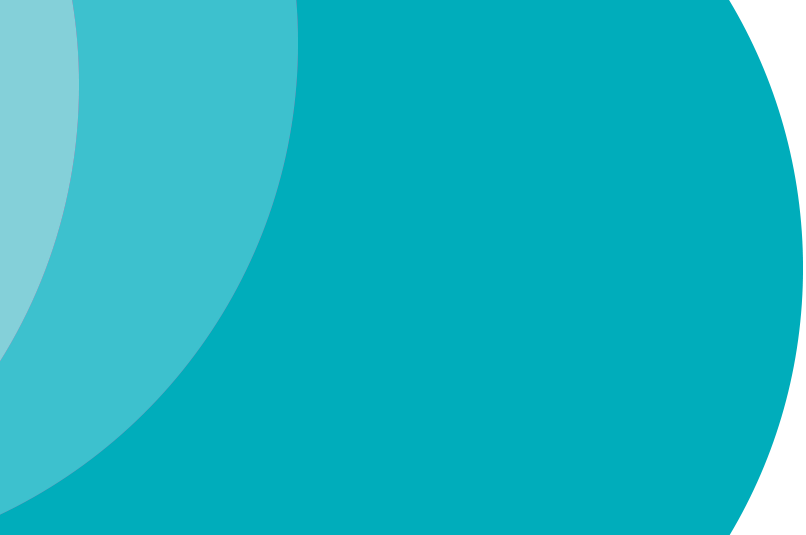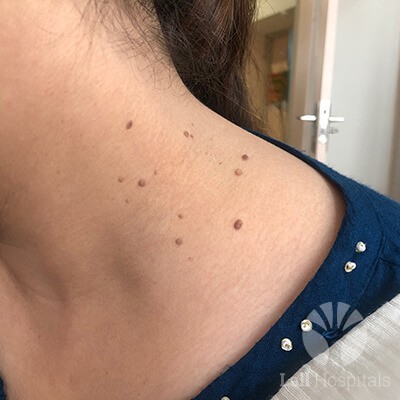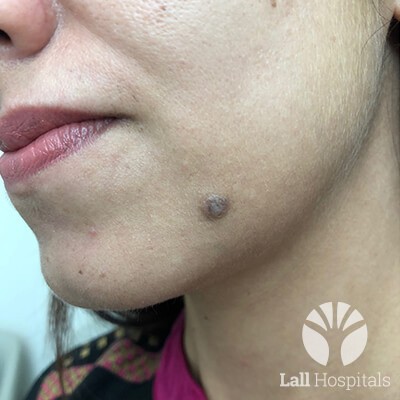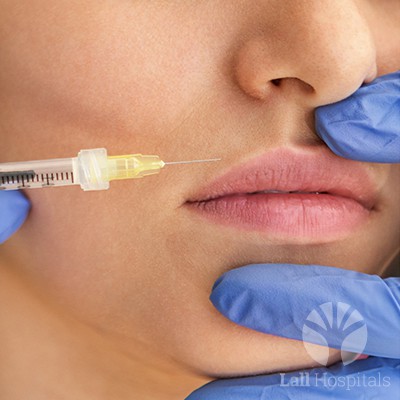Skin Science Procedures
Laser Hair Reduction
Procedure – Laser hair reduction involves beaming of specialised laser light into the hair follicles. The stem cells in the hair follicles absorb the light and are subsequently destroyed. The results of laser hair reduction are permanent, i.e. hair that is destroyed during a session does not grow back. About 10 – 30% of the hair roots are destroyed permanently in one session with results being evident in the very first session. With each subsequent session, the hair growth will be finer with hair pores on the skin becoming less visible.
At Lall Hospital, we use FDA-approved Lumenis Light Sheer Desire Diode laser, the golden standard in laser hair reduction. Each pulse of the laser takes a fraction of a second and can treat many hairs at the same time. Lasers selectively target dark, coarse hairs leaving the surrounding skin undamaged.
The treatment works best on dark hair and does not work on white, grey or very light-coloured hair. Moreover, women with PCOS (Polycystic Ovarian Syndrome) may experience poor results unless the treatment is supplemented with medication and lifestyle changes. At Lall Hospitals, we conduct a thorough check-up of all patients desirous of permanent hair reduction to rule out any other associated hormonal issues and address them simultaneously if they exist. This is offered as a complete package for hair reduction.
A majority of people require 6 to 8 sessions to get rid of 80-90% of their hair with a break of 4-6 weeks in between each session. As hair grows in cycles, a gap between sessions is essential to catch the majority of the hair. Patients should avoid shaving, waxing or threading a day or two before the session. Moreover, the treated area may be sensitive post session and must be treated with care.
A pain-free treatment with minimal discomfort and occasional short-term reactions such as redness and temporary swelling of the hair root sac, laser hair reduction is useful for removing unwanted hair including ingrowth from the face, leg, arm, underarm, back and other areas.
Ideal for – A painless, non-surgical procedure, with no special post-treatment care required, it works best on people with dark hair, with visible results after the very first session.
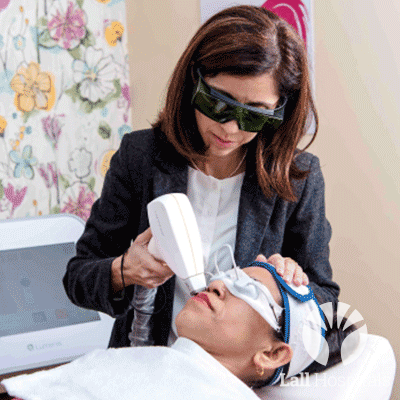
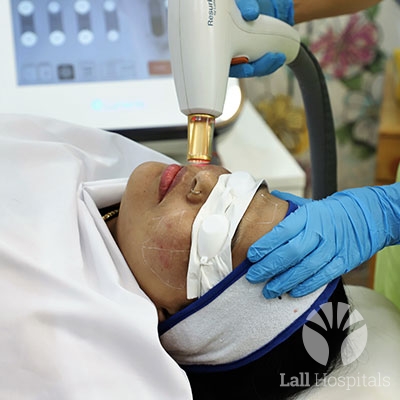
Laser Skin Resurfacing and Scar Treatment
Procedure – At times the skin can get scarred due to acne from a burn, surgery, accident or inflammation. With the latest laser technology these scars can be significantly reduced. The treatment is planned according to the nature of the scars and skin condition. The latest fractional lasers treatments, ablative (CO2) or non-ablative (Eb Glass/Eb Fibre), are used depending on the need.
Different modalities of treatment such as Scar Undermining, Scar Revisions, Resurfx Lasers, Acupulse, Radiofrequency, Microneedling, PRP, Minor Surgeries, Peels, and Fillers can be combined to get the best results.
The ResurFX™ laser by Lumenis is a new FDA-approved, advanced functioning non-ablative laser system that is extremely effective and patient-friendly. ResurFX™ uses a 1565 nm fibre laser and a very advanced scanner, which enables your doctor to choose from more than 600 combinations of shape, size and density for optimal treatment. The ResurFX™ handpiece is equipped with continuous contact cooling, to increase patient comfort during treatment.
The term ‘non-ablative’ means it does not destroy or ablate the skin cells while fractional indicates that the laser affects a fraction of the skin (as opposed to the entire skin surface). The laser is delivered to the skin in tiny dots, penetrating the lower layers in one pass, stimulating the skin to develop collagen without harm. As collagen increases, the skin looks tighter, more even, and more youthful.
The benefit of the treatment is that it is less harmful, more comfortable and safer for the patient. The skin shows only a mild redness which reduces in a day or two. An outpatient procedure, the ResurFX™ laser ensures optimum results with a minimum downtime. ResurFX is also commonly used to treat a variety of skin conditions, including acne and surgical scars, skin discoloration, periorbital wrinkles and stretch marks.
Ideal for – A safe and precise method for:
- Scars from acne or surgery
- Fine lines or wrinkles
- Lax or loose skin
- Stretch marks
- Keloids
- Open pores
- Discolouration
- Uneven skin tone
The Acupulse Fractional Carbon Dioxide (CO2) lasers, one of the latest advances in non-surgical skin rejuvenation treatments, is an aggressive laser treatment for deeper scars and wrinkles requiring more downtime and intensive post-treatment care to minimise exposure to the sun, dust etc. The laser removes layers of skin in a fractionated method – columns of skin are removed, leaving the skin surrounding each column intact to aid in healing. This process also stimulates the formation of new collagen, providing better elasticity and support to the skin.
Ideal for – A safe and effective treatment for:
- Acne, Burn, Hypertrophic or Accidental scars
- Wrinkles
- Stretch marks
- Forehead lines
- Keloids
- Warts
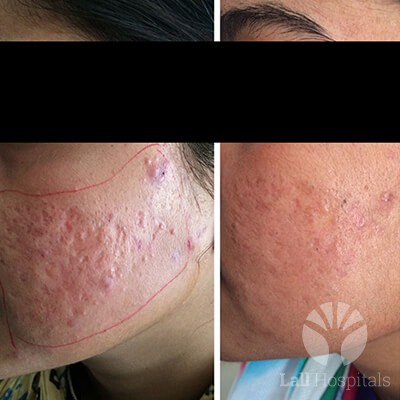
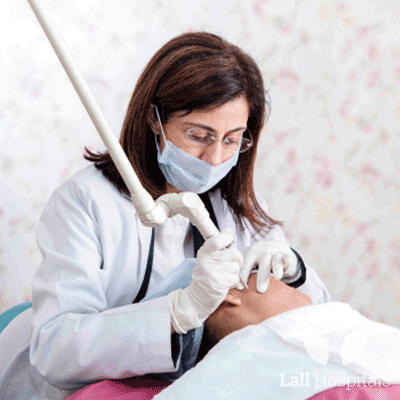
Removal of Unusual Skin Growth
What is Unusual Skin Growth?
Any growth on the skin which seems abnormal should be examined by a dermatologist. Dermatologists at Lall Hospitals thoroughly analyse a skin growth and can remove it if required. We offer various procedures like CO2 Laser, Cryosurgery, Radiosurgery, Electrosurgery for removal of different types of skin growths. The decision regarding the treatment is taking after an analysis of the skin growth, including size, thickness and location and the patient’s requirement. Laser treated areas have been found to heal faster with better cosmetic outcomes. A wholesome treatment of challenging warts using immunotherapy and intralesional injections is also undertaken.
Types of Unusual Skin Growth
- Warts – Warts are infectious growths caused by the Papillomavirus. They are painless and commonly seen as flat, raised or cauliflower-like protruding masses of skin. Their size may vary from a tiny speck in the early stages to several centimetres in the advanced stage. Commonly affected areas include hands, feet, face, genitals but any part of the body may get affected due to a transfer of the infection.
- Corns and Calluses – Corns and Calluses are hard, coloured and often painful thickening of the skin, commonly growing on feet. They can be effectively treated by proper counselling, medical and laser treatment, if required.
- Skin Tags or Acrochordons – Skin Tags are benign, fleshy skin growths that are usually seen around neck, breasts, groin folds, underarms and occasionally around the eyes. Painful when caught in clothing or jewellery, skin tags can be safely removed without any marks or scarring by our dermatologists using a variety of techniques. Home or self-removal is not advised as it can result in scarring, infections and significant pain.
- Moles – Moles or Melanocytic Nevi are small, often slightly raised growths on the skin usually brown or flesh-coloured which can be surgically excised (removed) if needed. Any abnormal change in the appearance of a mole should be examined.
- Sebaceous Cysts and Lipomas – Sebaceous Cysts and Lipomas are collections of oil (sebum) or fat underneath the skin. Surgical excision (removal) can be done for these if needed.
- Seborrheic Keratosis – Seborrheic Keratoses occur with ageing and are benign, waxy, warty-looking growths that can be yellow, brown or black. They occur on the face, scalp or trunk and can be easily and safely removed with laser or Cryotherapy.
- Cherry Angiomas – Cherry Angiomas are benign, small red or purple collection of blood vessels that can develop anywhere on the body and can be removed easily and safely by our dermatologists using the laser, Cautery or Cryotherapy.
- Milia Cysts – Milia Cysts are tiny white bumps, almost like deep whiteheads that develop on the face and often around the eyes at any age. They are benign and can be quickly and painlessly removed or extracted with great cosmetic results.
- DPNs (Dermatosis Papulosis Nigra) – DPNs are characterised by small brown or black spots that occur on the skin around the cheekbones, eyes, neck, chest, and back. This condition occurs most frequently in dark-skinned people. The spots may be flat or raised. Some people with DPN have a few, isolated spots while others may have hundreds of spots. These can be removed painlessly using laser or Radiosurgery with good results.
- Molluscum Contagiosum – It is a viral skin infection that causes either single or multiple raised, pearl-like bumps (papules) on the skin. Caused by a virus of the same name that is part of the pox virus family, it is contagious through direct contact and is more common in children. These growths should be addressed and treated on an urgent basis. The treatment is quicker and easier when a few lesions are already present. Removal of these lesions are possible if needed.
- Pyogenic Granulomas – Pyogenic Granulomas are skin growths that are small, round, and usually bloody-red in colour as they contain a large number of blood vessels. Prone to bleeding, these growths can occur after injuries, due to bug bites or rough scratching of the skin. However, they are benign (noncancerous) and can be safely removed through various methods.
- Xanthelasma or Cholesterol Deposits – These are soft, yellow plaques commonly occurring on the skin around eyes due to increased blood lipid levels. Though they are neither painful nor harmful, they can easily be removed by laser, chemicals or surgery as required.
- Keloids – These occur as hard growths due an abnormal wound healing response after injury (accident, surgery, ear piercing, inflammation etc). Though Keloids are challenging to treat, treatments like Intralesional Injections, Cryotherapy, lasers or Silicone Gel sheeting can be planned.
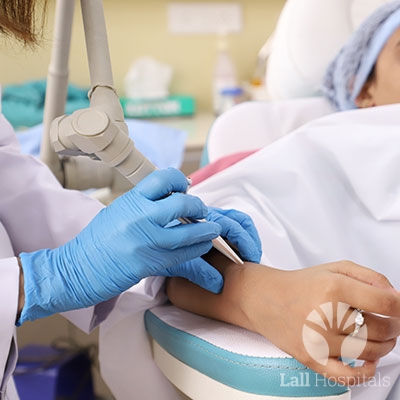
Treatments
The treatment for the above mentioned unusual skin growths can be done as per the indication with medical management, Extirpation, or by using CO2 Laser, Radiofrequency Surgery, Electrosurgery and Cryosurgery.
Carbon Dioxide (CO2) Laser
Cryosurgery
Radio Surgery
Electrosurgery
Surgical Excision
Removal of Birthmarks, Tattoos and Pigmentation
Procedure – At Lall Hospitals, we use lasers to remove birthmarks, tattoos and pigmentation. The Q-switched Nd:YAG laser provides a new paradigm for their treatment.
- Laser Tattoo Removal – We offer safe and effective tattoo removal for patients who may want to get rid of their tattoos for either practical or emotional reasons. Laser tattoo removal usually refers to a non-invasive removal of tattoo pigments using Q-switched Nd:YAG laser.
Process of Tattoo Removal – Tattoos consist of thousands of particles of tattoo pigment suspended in the skin. Tattoo removal is done by lasers that cause tattoo pigment particles to heat up and fragment into smaller pieces. The broken down ink is then removed by normal body processes. Typically, black and darker-coloured inks can be removed completely. However, complete laser tattoo removal requires numerous treatment sessions, typically spaced at least 4 weeks apart.
At each session, some but not all of the tattoo pigment particles are effectively fragmented, and the body removes the smallest fragments over the course of several weeks. The result is that the tattoo is lightened over time. The remaining large particles of tattoo pigment are then targeted at subsequent treatment sessions, causing further lightening. The number of sessions and spacing between treatments depends on various parameters, including the area of the body treated and skin colour.
- Birthmarks – Lasers are used to remove birthmarks like Nevus of ota, Cafe au lait and Mongolian spots. Effective for epidermal (superficial) and dermal (deep) pigmentation, the specific laser wavelength that is sensitive to a specific colour is chosen to target the lesion while sparing the surrounding normal tissue.
- Pigmentation – For freckles, age spots (Lentigines) and sun spots, the laser penetrate the skin without damaging it, breaking down the deep pigments into small particles which are absorbed by the white blood cells and removed. Repeated laser treatments are necessary at regular intervals for desired results.
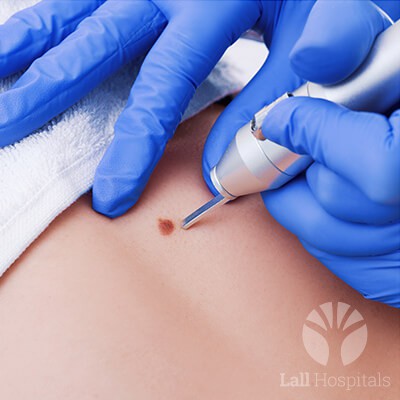
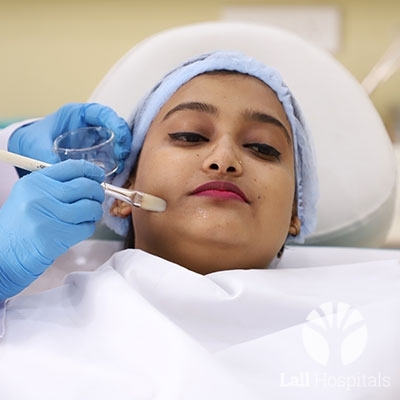
Chemical Peels
Procedure: Sun exposure, acne or even ageing can cause an uneven, wrinkled, spotted or scarred skin tone. A chemical peel uses a chemical solution to improve the texture and tone of your skin by removing the damaged outer layers and is one of the most cost effective ways to improve the appearance of your skin.
Although used mostly for the face, chemical peels can also be used to improve the skin on the neck, hands or back. Varying strengths of chemical peels are available, and the appropriate peel for each patient is selected depending on the skin type, desired results, and length of recovery time. Two or more peels can also be combined for better cosmetic results.
Ideal for: Chemical peels are used to treat many conditions including:
- Ageing skin
- Hyperpigmentation
- Melasma
- Sun-damaged skin
- Tanning
- Skin rejuvenation
- Uneven tone and texture
- Acne
Chemical Peels are not effective for:
- Deep wrinkles
- Saggy or loose skin
- Deep scars
Platelet Rich Plasma (PRP) Therapy
Procedure – PRP is a special therapy where the patient’s own blood is withdrawn to extract the platelet rich plasma which is then re-injected into the body. This plasma is known to be rich in numerous growth factors which help in wound healing and tissue regeneration. As it is derived from the patient’s own blood, it has no potential for causing an immune reaction.
At Lall Hospitals, we prepare the PRP at our own lab in the hospital premises, offering a better quality and reliability of the PRP.
Hair Growth
A new approach to hair treatment, PRP therapy supplies the scalp with various growth factors that are essential for hair growth. The platelet growth factors stimulate the dormant hair follicles resulting in the production of new hair and enhancing the hair growth and thickness in the next 3-4 months.
Skin Care
- Scar treatment: Containing beneficial growth factors, PRP may additionally be used with fat transfer or subcision to re-plump areas of lost volume or depressed scarring. Subcision surgically releases the pulled down portion of the scar from within, inducing the body’s healing response to create blemish free skin cells. When combined with fat transfer, PRP softens the appearance of depressed, rolling scars.
- Facial Rejuvenation – This face lift procedure combines the power of the PRP technology and facial fillers to minimise the signs of facial ageing. This non-surgical procedure promotes new tissue growth, improving overall facial skin tone for a younger appearance.
Ideal for – As PRP uses the body’s natural platelets, there is no risk of allergic reaction. With little to no swelling, bruising or lumping as the fluid assimilates in the natural skin environment, it is ideal for hair regrowth, face rejuvenation, treatment of under-eye dark circles, non-healing ulcers, and acne scars.
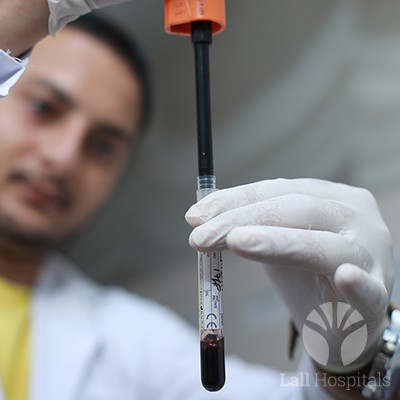
Anti-Ageing Procedures
Dermal Fillers
Botox Treatment
Facial Mesotherapy
Ear Lobe Repair
Procedure – The dilated, torn, or malformed area of the earlobe is removed, and the remaining earlobe is reconstructed to restore a normal appearing earlobe.
Ideal for: An outpatient procedure performed under local anaesthesia with minimum recovery time needed post-treatment, it is best suited for weighted earrings, ear gauges, dilators, or a torn earlobe from trauma.
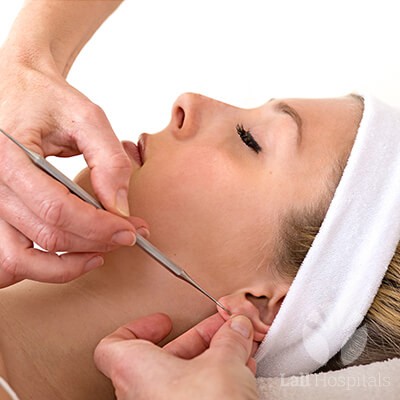
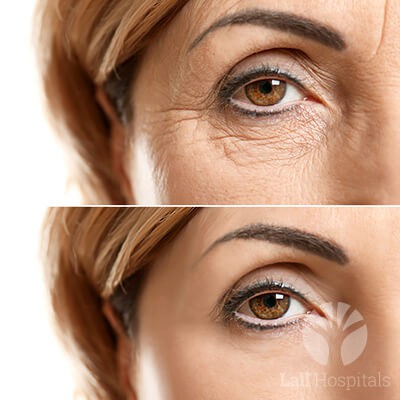
Eye Rejuvenation
Procedures- The skin around the eyes is thin and delicate and is one of the first areas of the body that show significant signs of ageing. With a host of treatment available at Lall Hospitals, patients can choose their treatment based on their requirement.
- Eyelid Surgery – It is a surgical procedure that can enhance the appearance of the eyelids. With ageing, excess skin and fat begin to accumulate around the eyelids, giving a puffy appearance to the eyes. Both the upper and lower eyelid surgery can be undertaken to correct this puffiness and drooping with the removal of fat, along with excess skin and muscle, giving the patient a more natural, younger appearance.
- Botox for wrinkles around eyes – Botox injections relax muscles, preventing skin from creasing and causing wrinkles and are very effective for the lines around the eyes. For more details, Read More
- Dermal Fillers and Tear Trough Correction – Dermal fillers can be used to treat under-eye dark circles, hollows and fine lines around the eyes. The under-eye area may have a hollowed look due to genetics, volume loss due to ageing, or from environmental and health factors such as excessive sun exposure, or cigarette smoking. Hollowness can affect the whole under-eye area all the way to the upper cheeks, or just the small area directly below the eyes called the tear trough. For more details, Read More
- Chemical Peels for the eyes – Chemical peels can be done right up to the lash line, treating wrinkles, improving the skin texture and tightening the skin. For more details, Read More



